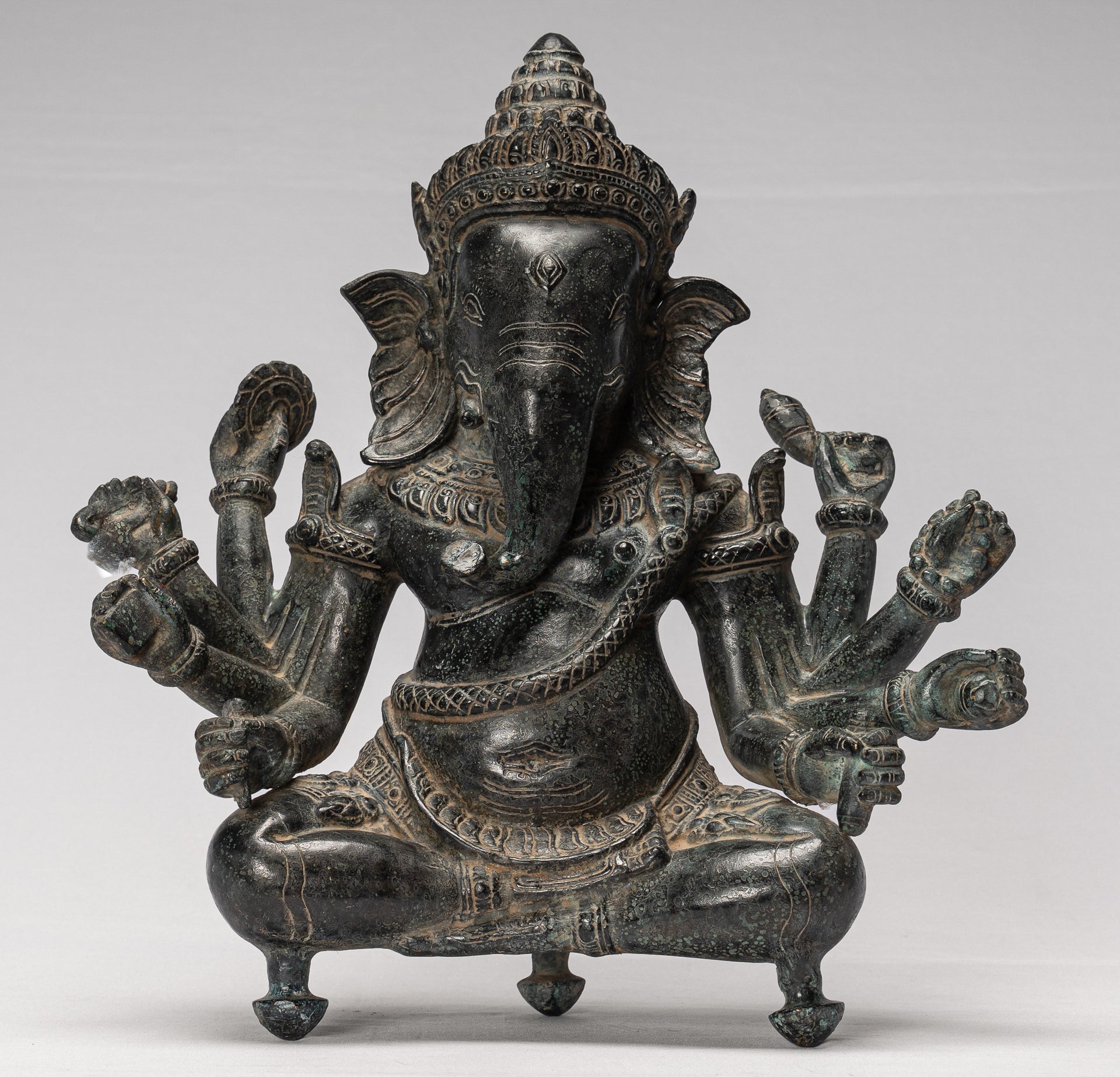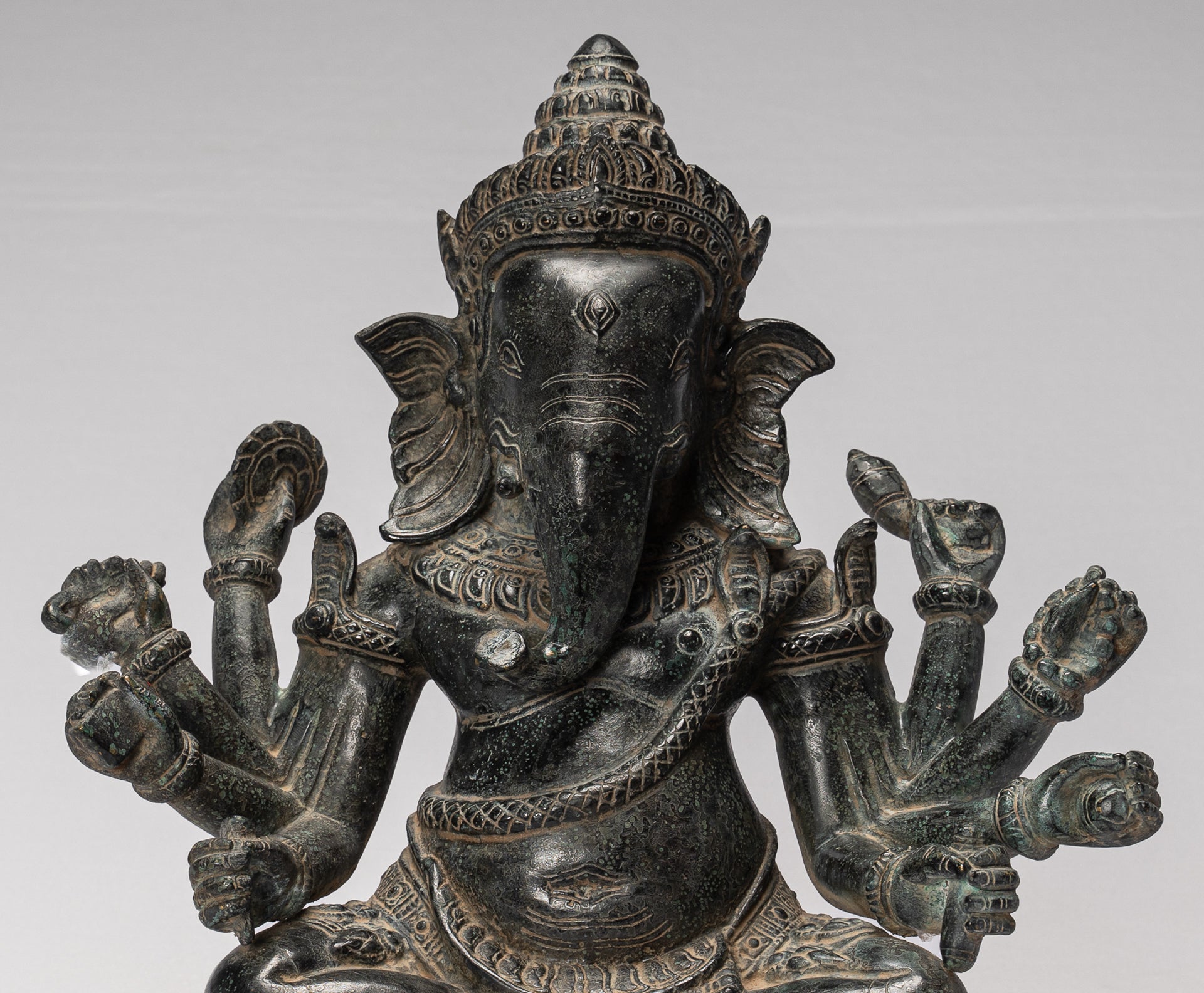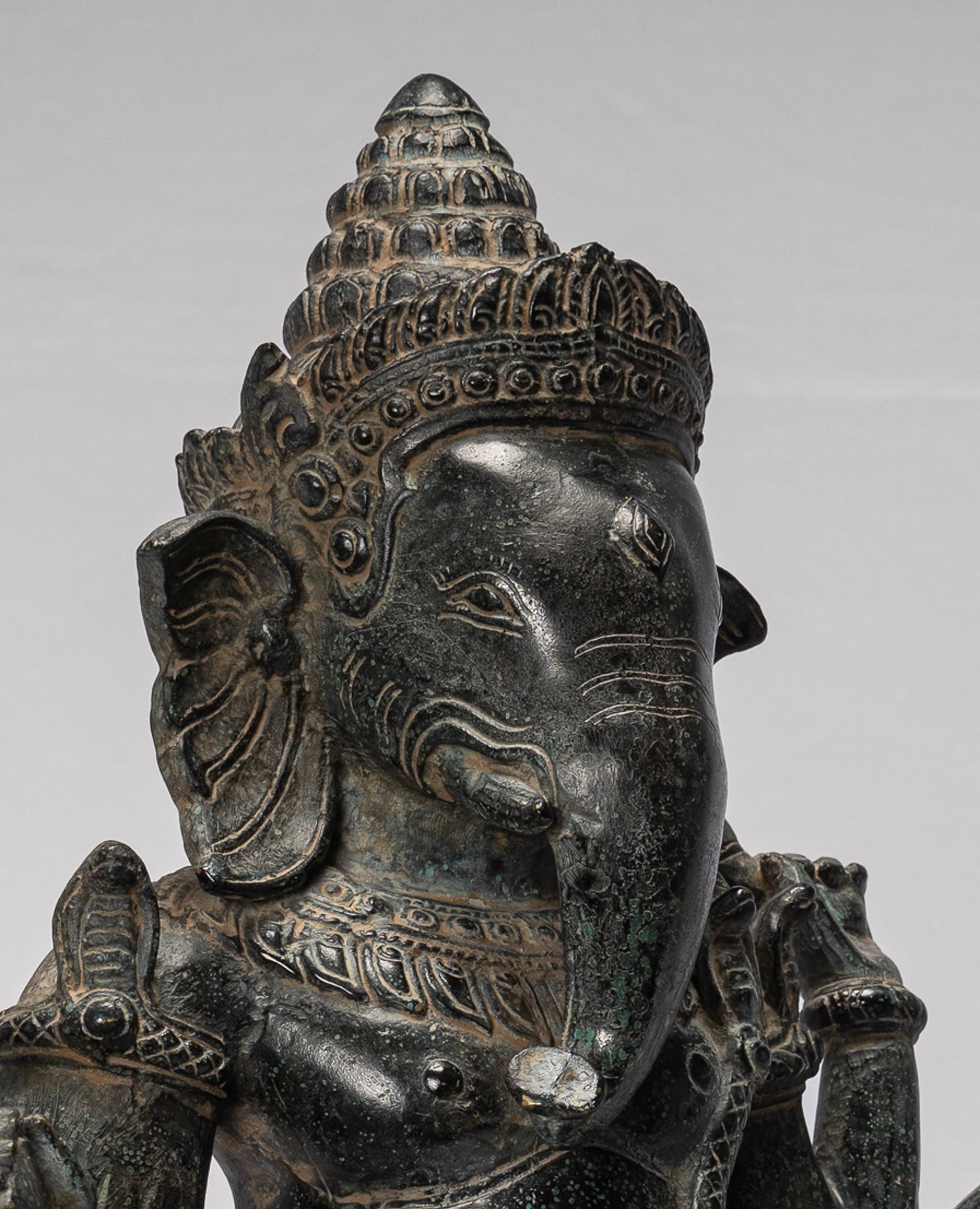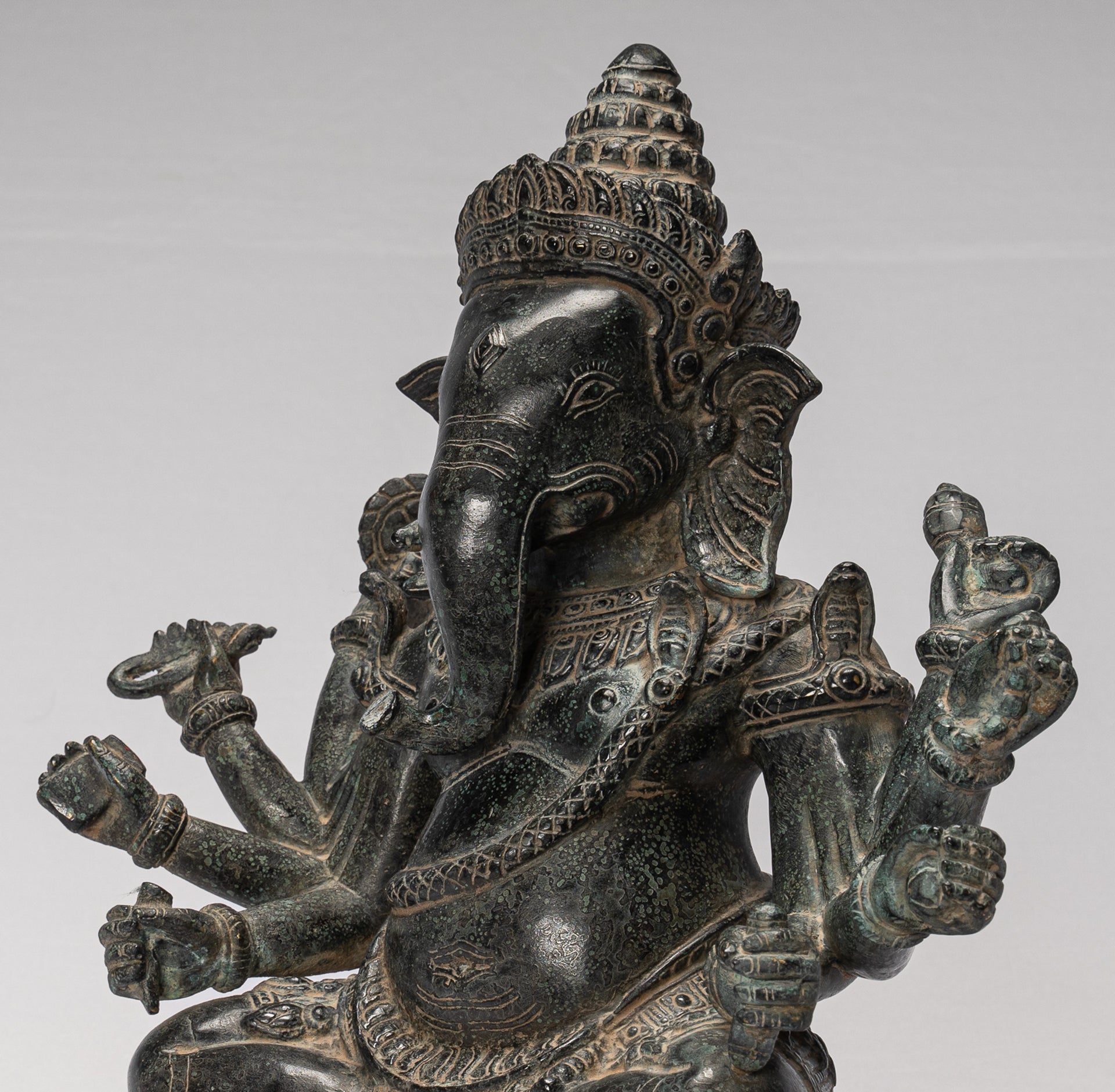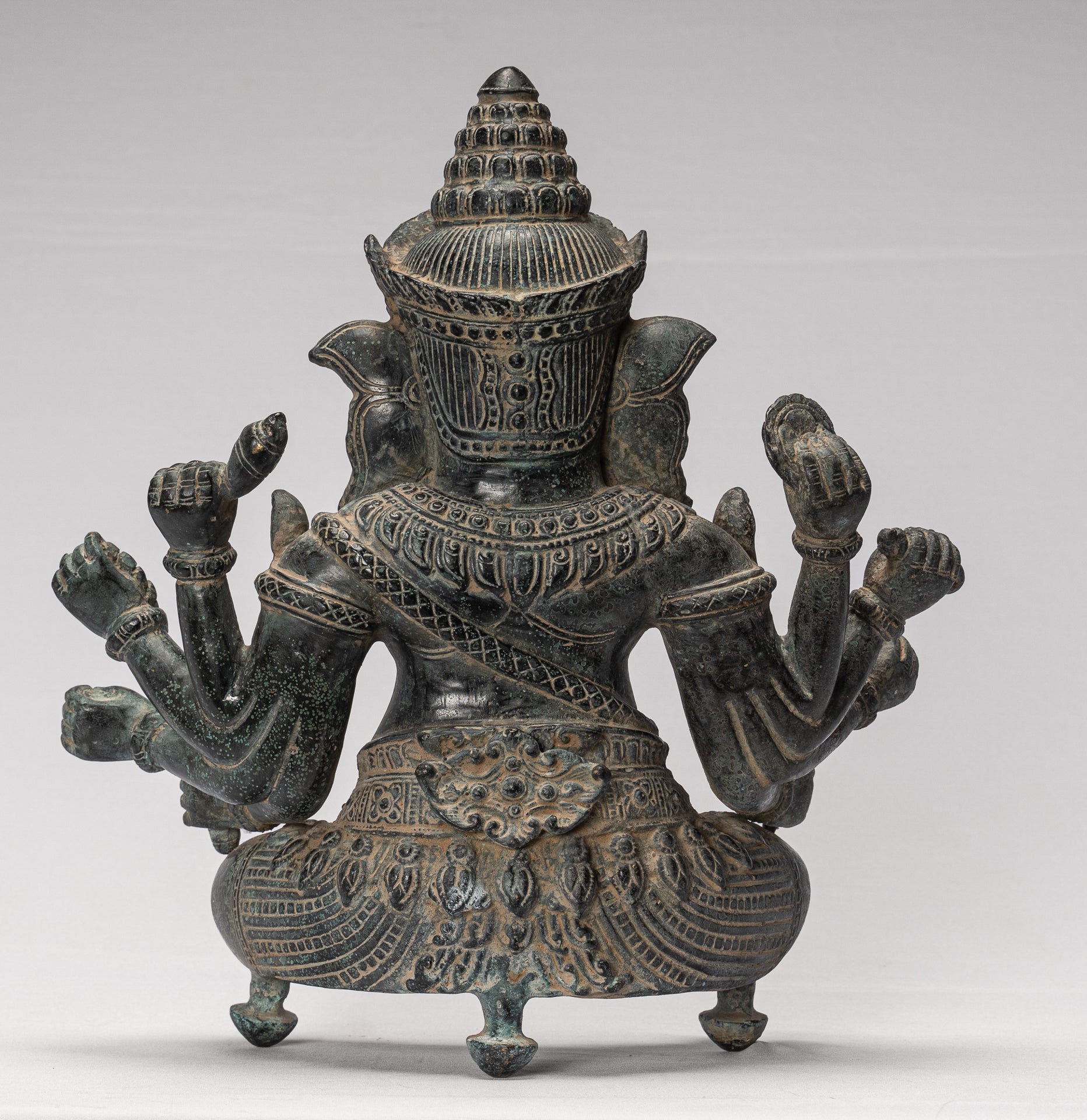-
Antique Khmer Style Bayon 8 Arm Ganesha Statue - 34cm/14"
Measures - (Height) 34cm/14"
An antique khmer style seated bronze Ganesha in 13th century, post Angkor, Bayon style.
Ganesha, the beloved and iconic deity of Hinduism, holds a multifaceted role as the god of various aspects of life. With his distinctive appearance of an elephant head on a human body, Ganesha is celebrated for his unique attributes and qualities that make him the deity of beginnings, wisdom, and obstacle removal.
Perhaps one of Ganesha's most well-known roles is that of the 'Vighnaharta', or 'Remover of Obstacles'. Ganesha's divine presence is believed to clear away impediments, both external and internal, that hinder one's progress in life. Devotees pray to him to overcome challenges, difficulties, and hurdles.
Ganesha's symbolism extends to the realm of inner obstacles, including ego, attachment, and ignorance. He teaches that true success and spiritual growth come from conquering these inner impediments.
Ganesha, the god of beginnings, wisdom, and obstacle removal, holds a central place in Hindu spirituality and daily life. His multifaceted symbolism resonates with people from all walks of life, transcending religious and cultural boundaries. Ganesha's blessings are sought by those embarking on new journeys, those seeking wisdom, and those facing life's challenges.
Ganesha is the elephant headed son of Shiva. He holds his broken tusk in one hand and a bowl of sweetmeats in another hand. He is also holding one of his spiritual weapons, the Chakra or discus, a sutra, mala beads, pinda, lotus bud and a musical conch shell.
The Chakra are discus, a circular spinning weapon, often referred to as the Sudarshana Chakra, represents the cycle of time, the eternal nature of the universe, and the destructive power of divine justice.
The sutra that Ganesha holds refers to an aphorism - a memorable expression of a general truth or principle. Sutras are a genre of ancient ad medieval texts found in Hinduism, Buddhism and Jainism.
Here, Ganesha is also holding the remnants of his broken tusk. The breaking of the tusk has several backstories. One instance suggests that it was shattered when Shiva cut the head off the elephant, prior to bestowing it onto Ganesha. Another writes that Ganesha’s quill broke and he needed a writing instrument – try telling your boss that next time you try to write up a report with an elephant tusk because your computer crashed. Regardless of its multiple origins, the holding of the tusk represents less of a keepsake, and more of a depiction that our spirituality is more important than our outer bodies, meaning we must overcome the duality of the two as separate entities.
The Pinda that Ganesha holds is typically formed of rice or barley.
The Conch Shell or Shankha symbolizes the primordial sound of creation, Om, from which the universe emerged. When blown, the conch produces a resonant sound that is believed to dispel negativity and create positive vibrations, signifying the creation and preservation of the cosmos. It also serves as a call to awaken spiritual seekers from their ignorance and guide them towards the path of righteousness.
The direction of Ganesha's trunk has symbolic meaning. Here the trunk turns to Ganesha's right. This represents Moksha or enlightenment. The perfect direction for those seeking or following a spiritual path.
In his early forms in India, Ganesha was associated with fertility. Later he became widely revered as the Remover of Obstacles and more generally as Lord of Beginnings and Lord of Obstacles, patron of arts and sciences and the deity of intellect and wisdom.
As a symbol of auspicious beginnings, profound wisdom, and the power to surmount obstacles, Ganesha inspires individuals to embrace life's transitions, pursue knowledge, and overcome adversity.
His enduring presence in Hinduism and the broader spiritual landscape underscores the universal human desire for guidance, wisdom, and a clear path toward success and spiritual enlightenment.
Ganesha remains a beloved and revered deity, embodying qualities that continue to inspire and uplift millions of devotees worldwide.
Ganesha is often found playing a musical instrument. Similar to Krishna Ganesha celebrates life through it's pleasures and beauty.
The distinctive patina of the piece is particularly delightful.
One of the most recognizable of the Asian deities this representation of Ganesha is sure to enlighten your home with endlessly timeless style.
SATISFACTION GUARANTEE - We have been offering SE Asian Art for many years and are proud of the reputation we have developed for fair and honest listings. However, if for any reason, whatsoever, you are unhappy with your purchase please just let us know and we will provide a full refund. We want you to be 100% happy with your purchase.
-
The majority of orders will be shipped with DHL. This is a secure, express and fully tracked service.
Items less than 2Kg we typically ship using Royal Mail.
Once we receive your order we try to ship all orders the same or next working day.
Large and/or fragile pieces requiring palletising, specialist crating and/or extra packaging may take a little longer. Palletised shipments will be delivered curbside.
All orders over 35 GBP will be shipped free of charge.

-
We genuinely hope that all purchases delight.
However, if they do not, regardless of reason, we will refund all orders upon receipt of the unwanted item. Just notify us within 14 days of receiving your order that you wish to make a return and send the piece back to us with 30 days of delivery.
Gandhara Buddha statues mark a turning point in Buddhist art, where the Buddha was first shown in fully human form with a striking blend of Indian and Greco‑Roman aesthetics.
They are essential for understanding how Buddhism spread along the Silk Road and how visual culture translated spiritual ideas into a universal, approachable image.


